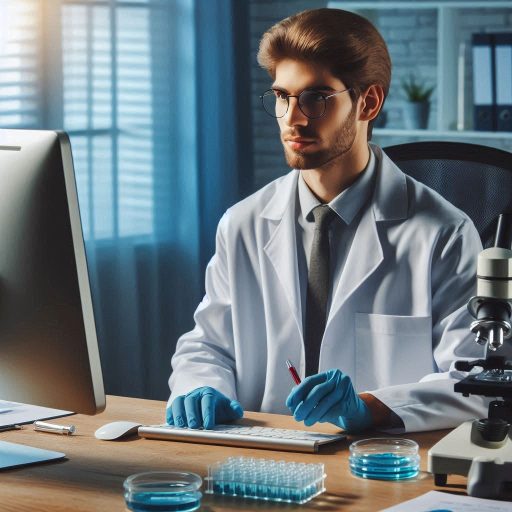Introduction
A biostatistician is a professional who applies statistical methods to the vast world of healthcare and medical research.
They play a crucial role in analyzing and interpreting data collected from clinical trials, public health studies, genetic research, and more.
Biostatisticians gather and organize complex datasets, working closely with medical researchers to ensure accurate and reliable outcomes.
Their work involves designing studies, determining appropriate sample sizes, and using advanced statistical software to interpret the data, ultimately helping to answer critical questions in healthcare.
The importance of biostatisticians in healthcare and research cannot be overstated.
Their analyses drive the discovery of new treatments, ensure the safety and efficacy of drugs, and improve public health policies.
Without their expertise, many medical advancements would be based on flawed or incomplete data.
Biostatisticians also help identify disease trends, risk factors, and treatment outcomes, guiding healthcare providers in making informed decisions that can save lives and improve patient care.
In the field of public health, biostatisticians analyze data from large populations, providing insights into disease outbreaks, healthcare disparities, and the effectiveness of preventive measures.
Their work helps shape government policies, health programs, and global health strategies aimed at improving population well-being.
Morning Routine
Wake up and Prepare for the Day
A biostatistician‘s day typically begins early.
After waking up, they focus on preparing mentally for the tasks ahead.
A clear routine can help set the tone for a productive day.
This usually involves grabbing a healthy breakfast, reviewing any pressing work thoughts, and maybe a quick workout or meditation session to boost focus.
A structured morning routine is vital for handling the detailed and sometimes intense nature of a biostatistician’s work.
With everything in order, the day can begin with a strong mindset, ready to dive into data analysis and meetings.
Check Emails and Respond to Any Urgent Requests
Once the biostatistician sits at their desk, the first task is to check emails.
In this field, timely communication is critical, as biostatisticians often work on multiple projects simultaneously.
Whether it’s an inquiry from a research team needing immediate feedback or a data request from a client, responding promptly to urgent emails helps keep projects on track.
Emails often involve updates on clinical trials, data requests, or progress reports that require immediate attention.
By tackling urgent requests first, they can avoid delays in project timelines.
Review Schedule for the Day and Prioritize Tasks
After addressing emails, the next step is to review the day‘s schedule.
Biostatisticians manage a variety of tasks each day, from meetings with research teams to data analysis.
Reviewing the schedule helps set the flow of the day and ensures that no deadlines are missed.
By looking at the bigger picture, biostatisticians can plan how much time to allocate to each task.
Whether it‘s preparing a report, running statistical models, or reviewing trial data, everything gets sorted into a clear priority list.
Prioritizing tasks is key to maintaining efficiency, especially when managing several projects.
For instance, if a research team needs preliminary data results for an upcoming meeting, that task will take priority over routine work.
Urgent tasks get done first, ensuring that important deadlines are met.
Strategic time management allows for focused work sessions, making it easier to switch between tasks without losing track of details.
A biostatistician‘s day begins with mental preparation and clear planning.
After waking up and going through their morning routine, the first work-related action is to check emails, responding to urgent matters that need immediate attention.
Following this, a review of the schedule helps set the pace for the day.
Prioritizing tasks based on urgency ensures the biostatistician handles everything efficiently, maintaining focus and productivity throughout their workday.
This structured approach allows them to stay on top of multiple projects while managing the intricate details their job requires.
Data Analysis
Work on Analyzing Data from Recent Research Studies
Biostatisticians play a critical role in interpreting data from recent research studies.
Their day often begins with analyzing large datasets derived from clinical trials, public health studies, or medical experiments.
Armed with statistical software, they transform raw numbers into meaningful insights that researchers and stakeholders can use.
This process involves identifying patterns, trends, and anomalies that may impact the study’s conclusions.
Biostatisticians rely on tools like R, SAS, or Python to streamline the data analysis process.
These tools allow them to perform complex calculations with speed and precision.
By running various models and tests, they ensure that the data is both valid and reliable.
They spend significant time selecting the appropriate statistical methods, ensuring the results align with the research questions.
Use Statistical Software to Interpret and Present Findings
After completing the initial data analysis, biostatisticians focus on presenting the results.
This involves translating statistical jargon into clear, actionable reports.
Charts, graphs, and tables help summarize complex data in a visual format, making it easier for others to comprehend.
Effective communication is key, as these findings are often shared with researchers, physicians, or public health officials.
A biostatistician’s ability to distill information into accessible formats is essential to advancing research conclusions.
In doing so, they contribute directly to improving healthcare interventions or shaping policy decisions.
Collaborate with Other Team Members to Ensure Accuracy of Results
Collaboration is another significant part of a biostatistician’s daily routine.
They work closely with other researchers, data analysts, and healthcare professionals.
Together, they review the statistical models and findings, ensuring accuracy and relevance to the study’s goals.
This collaborative effort helps eliminate potential errors and biases that could skew the results.
Biostatisticians often participate in meetings or discussions to clarify their methodologies and answer any questions about the data’s interpretation.
This collaboration fosters an environment of accuracy and precision, which is vital in research settings.
Additionally, biostatisticians provide feedback to their peers, suggesting alternative methods for data collection or analysis.
They also review the integrity of the datasets, verifying that the data collected aligns with the study’s protocols.
This oversight ensures that the results are not only accurate but also reproducible, which is crucial in scientific research.
By working as part of a team, biostatisticians contribute to a broader effort of refining research processes and outcomes.
In review, a biostatistician‘s day is a blend of technical expertise and collaboration.
From analyzing complex datasets to presenting clear, actionable results, they play an indispensable role in shaping research outcomes.
Through teamwork and precision, they ensure the reliability of findings that can influence healthcare decisions and scientific advancements.
Read: Profiles in Success: Leading Chemists of the 21st Century in the US
Meetings and Collaborations
Attend Meetings with Researchers and Healthcare Professionals to Discuss Ongoing Projects
Biostatisticians play a crucial role in the success of research projects.
Their day often begins by attending meetings with researchers and healthcare professionals.
During these meetings, biostatisticians discuss the status of ongoing projects and address any challenges.
They work closely with teams to ensure that the statistical aspects of the study are aligned with the research objectives.
Their presence in these discussions is essential for making informed decisions about study progress and potential changes.
This collaboration ensures that all team members are on the same page regarding goals, methods, and timelines.
Collaborate on Study Design and Data Collection Methods
Another key part of a biostatistician‘s day is collaborating with researchers on study design.
They provide expert advice to ensure that the study structure will yield accurate and reliable results.
Study design is critical because it lays the foundation for collecting meaningful data.
Biostatisticians help define control groups, sample sizes, and variables to measure.
They also work closely with researchers to select appropriate data collection methods.
Ensuring that data is collected consistently and accurately across participants is vital for the integrity of the study.
Effective collaboration on these elements helps prevent errors that could skew results later.
Provide Input on Statistical Analysis Techniques
After the study design and data collection are finalized, biostatisticians provide input on statistical analysis techniques.
These techniques are essential for interpreting the data gathered during the study.
Biostatisticians recommend the most appropriate statistical models to analyze complex datasets and test hypotheses.
They also ensure that the chosen methods align with the research questions and objectives.
Proper statistical analysis is crucial for identifying trends, relationships, and outcomes in the data.
Their expertise in this area helps researchers draw valid conclusions and supports evidence-based decision-making in healthcare.
The role of a biostatistician is highly collaborative and analytical.
By attending meetings with researchers and healthcare professionals, they ensure alignment on project goals and progress.
Their input on study design and data collection methods helps set the foundation for reliable research.
Furthermore, their expertise in statistical analysis techniques is key to extracting meaningful insights from complex data.
Through their contributions, biostatisticians help drive successful research outcomes that inform medical decisions and public health policies.
Their work is essential for advancing healthcare through rigorous and data-driven research processes.
Read: The Life and Times of a U.S. Physicist: A Day in Detail
Problem Solving
As a biostatistician, problem-solving is a crucial aspect of my daily work routine. Here are some of the key tasks I undertake
Addressing Data-Related Issues
One of the most common challenges I face is dealing with unexpected data issues that arise during the course of a project.
This could include missing data, data entry errors, or inconsistencies in the data set.
When faced with such issues, I need to quickly identify the root cause of the problem and come up with a solution to ensure the integrity of the data.
This may involve collaborating with data managers or research assistants to rectify the issues and prevent them from impacting the analysis.
Troubleshooting Errors
In addition to data-related issues, I also have to troubleshoot errors that occur in analysis programs or statistical software.
This could range from syntax errors in coding to software bugs that affect the accuracy of the results.
As a biostatistician, I need to have a keen eye for detail and the ability to systematically debug and correct errors in the code to ensure the validity of the analysis.
Finding Solutions to Statistical Challenges
Working on ongoing projects often presents statistical challenges that require innovative solutions.
This could involve designing new statistical methodologies, adapting existing techniques to suit the research question, or overcoming limitations in the available data.
As a biostatistician, I constantly strive to find creative solutions to these challenges while maintaining the rigor and validity of the statistical analysis.
Basically, problem-solving is an integral part of a biostatistician’s day-to-day activities.
It requires a combination of technical expertise, analytical thinking, and attention to detail to address data-related issues, troubleshoot errors, and find solutions to statistical challenges effectively.
Read: Salary Ranges: What to Expect as a Physicist in the USA

Research and Development
Staying Up to Date on the Latest Advancements in Biostatistics
In a typical day, biostatisticians must stay current with the latest advancements in their field.
Biostatistics is a rapidly evolving discipline, with new statistical methods and tools constantly emerging.
To remain competitive, biostatisticians need to dedicate time to research and learning.
They read scholarly articles, attend webinars, and follow industry trends.
By actively engaging with recent studies, biostatisticians ensure they can implement cutting-edge techniques in their work.
This continuous learning is crucial for improving data accuracy and the quality of statistical analyses.
Researching New Statistical Methods and Tools to Improve Data Analysis
Biostatisticians also spend a significant portion of their day researching new statistical methods and tools.
Finding the right approach to analyzing complex datasets can make a significant difference in a project’s outcomes.
They explore advanced algorithms, machine learning models, and specialized software platforms that can enhance their analysis capabilities.
By testing and validating new methods, they can provide more reliable and insightful results.
This process often involves collaboration with other researchers and statisticians, ensuring that their methods are robust and applicable to real-world problems.
Staying open to innovation allows biostatisticians to tackle complex challenges in medical research, public health, and pharmaceutical development.
For example, a new statistical model could improve clinical trial designs or help identify trends in disease outbreaks.
The ability to adapt and incorporate these advancements gives biostatisticians a competitive edge in their careers.
Transform Your Career Today
Unlock a personalized career strategy that drives real results. Get tailored advice and a roadmap designed just for you.
Start NowDeveloping New Strategies for Data Visualization and Interpretation
Presenting data in a clear, understandable way is a key part of a biostatistician‘s role.
After completing analyses, they often need to explain their findings to non-experts, such as doctors, policy-makers, or other researchers.
Biostatisticians focus on developing new strategies for data visualization and interpretation to make complex results accessible.
They create detailed charts, graphs, and interactive models that simplify the interpretation of statistical findings.
Mastering visualization tools like R, Python, and Tableau allows biostatisticians to craft impactful presentations.
These visuals help stakeholders make informed decisions based on the data.
When dealing with sensitive subjects, such as clinical trials or public health data, clarity and precision in data interpretation are critical.
Biostatisticians take pride in turning raw numbers into actionable insights, ensuring their work has a tangible impact on real-world outcomes.
In their day-to-day tasks, biostatisticians balance learning, innovation, and communication.
By staying current with the latest advancements, researching new methods, and refining data visualization techniques, they continuously improve their ability to analyze and present complex datasets.
This commitment to growth ensures their work remains relevant and impactful in a rapidly evolving field.
Read: Physics Specializations: Choosing Your Path in the U.S.
You Might Also Like: Pharmacology Internships: How to Find the Best Ones
Quality Control
Conduct Quality Control Checks on Data Sets and Analysis Results
A critical responsibility of a biostatistician is conducting quality control checks on data sets and analysis results.
This step ensures that the data used in research studies is free from errors or inconsistencies.
Biostatisticians review every data point, identifying missing or duplicated entries, which can distort the analysis.
They also cross-check the results of statistical tests to confirm accuracy.
By maintaining stringent quality control processes, biostatisticians help avoid inaccurate conclusions, which could impact study outcomes.
Ensuring that the data is clean and reliable from the start is essential for high-quality research.
Ensure Data Integrity and Accuracy in All Statistical Analyses
Once data sets are cleaned, the next step is to ensure data integrity and accuracy in the statistical analyses.
Biostatisticians meticulously review the data before it‘s subjected to statistical models, verifying that the structure is consistent with the research objectives.
They check for outliers or anomalies, which could skew the results, and ensure that data transformations are applied correctly.
Additionally, they confirm that data collection protocols have been followed to the letter.
Every analysis is double-checked to guarantee that the statistical interpretations are accurate and reflect the true nature of the data.
Review and Validate Statistical Models Used in Research Studies
Biostatisticians play a key role in reviewing and validating the statistical models used in research studies.
They ensure that the chosen models fit the data appropriately and align with the study‘s design.
This process involves verifying that the assumptions of the model are met and that it effectively represents the relationships between variables.
Biostatisticians often test multiple models to determine which one offers the most reliable results.
Once a model is selected, it undergoes further validation to confirm its robustness and suitability for the research.
To validate a statistical model, biostatisticians run tests such as residual analysis and goodness-of-fit tests.
These checks help confirm that the model provides an accurate representation of the underlying data.
If any discrepancies or biases are detected, they adjust the model accordingly.
Model validation is an iterative process, ensuring that the results generated are trustworthy and can be replicated in future studies.
Biostatisticians are highly detail-oriented, as even minor errors in model selection or validation can significantly impact the study‘s conclusions.
In summary, biostatisticians are dedicated to conducting thorough quality control checks on data sets and analysis results.
They ensure the integrity and accuracy of data, which is crucial for reliable statistical analyses.
By reviewing and validating statistical models, biostatisticians help produce accurate and robust research findings that advance scientific knowledge.
Their work is vital to maintaining the credibility of statistical analysis in research, ensuring that conclusions are based on accurate, validated models and data.
Documentation and Reporting
Document Data Analysis Processes and Results for Future Reference
When analyzing large datasets, biostatisticians must meticulously record every step.
They document data cleaning methods, statistical models, assumptions made, and any decisions regarding outliers or missing data.
This detailed documentation not only aids their current work but also provides a reference for future projects.
It ensures that others can replicate the analysis if needed, which is essential for scientific accuracy.
Clear records support consistency in methodology and make it easier to compare results across studies.
Prepare Reports and Presentations to Communicate Findings to Stakeholders
Beyond analysis, biostatisticians are responsible for preparing detailed reports and presentations.
These are used to communicate findings to a wide variety of stakeholders, including scientists, healthcare professionals, and decision-makers.
The reports contain a clear breakdown of the methodologies used, key statistical findings, and relevant interpretations.
By organizing their data into graphs, tables, and charts, biostatisticians make it easier for stakeholders to absorb complex information.
Presentations offer an opportunity to showcase these findings visually, often using slides and infographics to enhance comprehension.
This process is critical for driving evidence-based decisions in research, policy, and clinical practice.
Summarize Key Findings in a Clear and Concise Manner for Non-Statistical Audiences
Communicating findings effectively to non-statistical audiences requires simplifying complex data.
Biostatisticians must summarize their results in a way that retains the accuracy of the data while making it easy to understand.
Whether the audience includes executives, patients, or community leaders, biostatisticians tailor their message to suit the listener’s background.
This means avoiding jargon and focusing on clear, concise explanations of the results.
The ability to translate statistical concepts into everyday language is an essential skill for any biostatistician.
It ensures that their work can influence decisions that impact public health outcomes.
Another critical aspect of communication is focusing on the key takeaways.
A biostatistician must be able to sift through vast amounts of data and identify the most significant findings.
This means focusing on outcomes that are statistically and clinically relevant.
For example, if analyzing the effectiveness of a new drug, they would emphasize the statistical significance of the results and the real-world impact on patient health.
By doing so, biostatisticians ensure that their reports and presentations are both informative and actionable.
Essentially, the role of a biostatistician goes beyond just crunching numbers.
From documenting each step of the analysis to summarizing key findings, they help bridge the gap between data and decision-making.
Through clear communication, they ensure that their complex analyses can drive meaningful outcomes in health and medicine.
Conclusion
Biostatisticians are essential to healthcare and research, providing the critical data analysis needed for medical advancements and public health decisions.
Their work directly impacts patient care, disease prevention, and the development of new treatments.
From designing clinical trials to analyzing epidemiological data, biostatisticians ensure that research findings are accurate, reliable, and applicable to real-world health challenges.
The responsibilities of a biostatistician are diverse and require a unique blend of skills.
They must design studies that can effectively answer research questions, often collaborating with doctors, scientists, and public health officials.
They analyze vast amounts of data, interpret results, and ensure that conclusions are based on sound statistical principles.
This requires strong analytical skills, attention to detail, and a deep understanding of both statistics and the healthcare environment.
For those interested in both numbers and medicine, biostatistics offers an exciting and rewarding career.
This field provides the opportunity to use data to improve healthcare outcomes, contribute to groundbreaking research, and shape public health policies.
Biostatisticians work across a range of sectors, including academia, government, pharmaceutical companies, and research institutions, making their expertise highly sought after.




